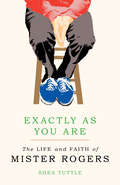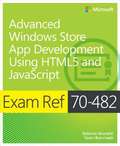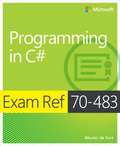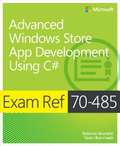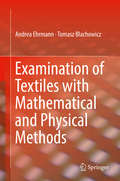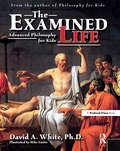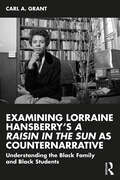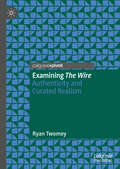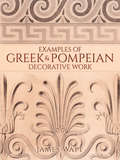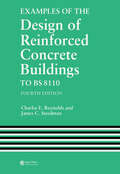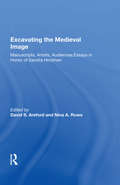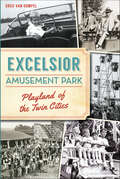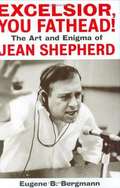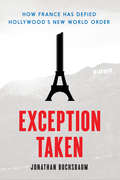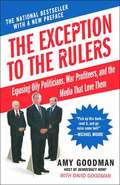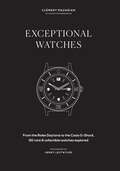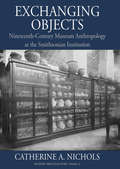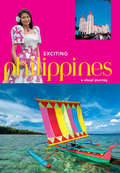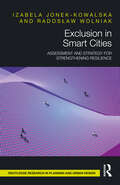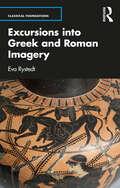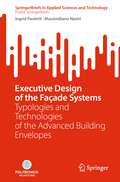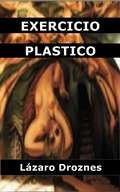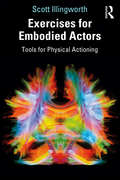- Table View
- List View
Exactly as You Are: The Life and Faith of Mister Rogers
by Shea TuttleWelcome to the spiritual neighborhood of Fred Rogers&“I like you as you are Exactly and precisely I think you turned out nicely And I like you as you are.&”Fred Rogers fiercely believed that all people deserve love. This conviction wasn&’t simply sentimental: it came directly from his Christian faith. God, he insisted, loves us just the way we are. In Exactly as You Are, Shea Tuttle looks at Fred Rogers&’s life, the people and places that made him who he was, and his work through Mister Rogers&’ Neighborhood. She pays particular attention to his faith—because Fred Rogers was a deeply spiritual person, ordained by his church with a one-of-a-kind charge: to minister to children and families through television. Tuttle explores this kind, influential, sometimes surprising man: the neighborhood he came from, the neighborhood he built, and the kind of neighbor he, by his example, calls all of us to be. Throughout, Tuttle shows how he was guided by his core belief: that God loves children, and everyone else, exactly as they are.
Exam Ref 70-482: Advanced Windows Store App Development Using HTML5 and JavaScript
by Roberto Brunetti Vanni BoncinelliPrepare for Microsoft Exam 70-482--and help demonstrate your real-world mastery of building Windows Store apps with HTML5 and JavaScript. Designed for experienced developers ready to advance their status, Exam Ref focuses on the critical-thinking and decision-making acumen needed for success at the MCSD level. Focus on the expertise measured by these objectives: Develop Windows Store apps Discover and interact with devices Program user interaction Enhance the user interface Manage data and security Prepare for a solution deployment This Microsoft Exam Ref: Organizes its coverage by exam objectives. Features strategic, what-if scenarios to challenge you. Includes a 15% exam discount from Microsoft. (Limited time offer)
Exam Ref 70-483: Programming in C#
by Wouter De KortPrepare for Microsoft Exam 70-483--and help demonstrate your real-world mastery of programming in C#. Designed for experienced software developers ready to advance their status, Exam Ref focuses on the critical-thinking and decision-making acumen needed for success at the Microsoft Specialist level. Focus on the expertise measured by these objectives: Manage Program Flow Create and Use Types Debug Applications and Implement Security Implement Data Access This Microsoft Exam Ref: Organizes its coverage by exam objectives. Features strategic, what-if scenarios to challenge you. Includes a 15% exam discount from Microsoft. Offer expires 12/31/2017.
Exam Ref 70-485: Advanced Windows Store App Development Using C#
by Roberto Brunetti Vanni BoncinelliPrepare for Microsoft Exam 70-485--and help demonstrate your real-world mastery of building Windows Store apps with C#. Designed for experienced developers ready to advance their status, Exam Ref focuses on the critical-thinking and decision-making acumen needed for success at the MCSD level. Focus on the expertise measured by these objectives: Develop Windows Store apps Discover and interact with devices Program user interaction Enhance the user interface Manage data and security Prepare for a solution deployment This Microsoft Exam Ref: Organizes its coverage by exam objectives. Features strategic, what-if scenarios to challenge you. Includes a 15% exam discount from Microsoft. (Limited time offer)
Examination of Textiles with Mathematical and Physical Methods
by Andrea Ehrmann Tomasz BlachowiczThis book presents basic knowledge on the examination of textile materials, from fibers to yarns and knitted or woven fabrics, using mathematical and physical methods. Besides typical textile test procedures, defined by well-known standards, the book aims at showing new ways to examine textile materials and giving an overview of the possibilities as well as problems occurring when methods from other areas are transferred into the examination of textiles. The contents range from apparently simple measurements, such as resistance of conductive coatings on woven fabrics, to diffraction measurements on woven fabrics, to optical examination of knitted fabrics by mathematical approaches to study yarn hairiness and cover factor.
The Examined Life: Advanced Philosophy for Kids (Grades 7-12)
by David A. WhiteIn this book, the follow-up to the best-sellingPhilosophy for Kids, Dr. David White delves deeper into the philosophical questions kids (and adults) care about deeply. Through vibrant discussions and debate, the book offers ways teachers can help students grapple with age-old questions about the nature of friendship (Aristotle), time (Augustine), knowledge (Plato), existence of God (Aquinas), perception (Berkeley), freedom and society (Rousseau), and many more.The book is divided into three sections. Part 1 presents primary source readings that will encourage discussion and debate; Part 2 offers easy-to-use activities that focus on the direct application of philosophy to areas such as critical thinking, language, and the arts; and Part 3 offers a unique perspective just for teachers—a philosophical look at how teachers can become more reflective philosophers themselves. This is an excellent teachers' handbook for using advanced philosophy in the classroom.Grades 7-12
Examining Lorraine Hansberry’s A Raisin in the Sun as Counternarrative: Understanding the Black Family and Black Students
by Carl A. GrantExamining Lorraine Hansberry’s A Raisin in the Sun as Counternarrative: Understanding the Black Family and Black Students shows how and why Lorraine Hansberry’s play, A Raisin in the Sun, should be used as a teaching tool to help educators develop a more accurate and authentic understanding of the Black Family. The purpose of this book is to help educators develop a greater awareness of Black children and youth’s, humanity, academic potential and learning capacity, and for teachers to develop the consciousness to disavow white supremacy, American exceptionalism, myths, racial innocence, and personal absolution within the education system. This counternarrative responds to the flawed and racist perceptions, stereotypes, and tropes that are perpetuated in schools and society about the African American family and Black students in US schools. It is deliberative and reverberating in addressing anti-Black racism. It argues that, if Education is to be reimagined through a social justice structure, teachers must be educated with works that include Black artists and educators, and teachers must be committed to decolonizing their own minds. Examining Lorraine Hansberry’s A Raisin in the Sun as Counternarrative: Understanding the Black Family and Black Students is important reading for undergraduate and postgraduate courses in Educational Foundations, Curriculum and Instruction, Education Policy, Multicultural Education, Social Justice Education, and Black Studies. It will also be beneficial reading for in-service educators.
Examining The Wire: Authenticity and Curated Realism
by Ryan TwomeyThis book examines The Wire’s authenticity and its establishment of the series realism. Along with tracing creator David Simon’s onscreen critique of numerous failed American institutions, the book focuses on the connection between authenticity and realism in three distinct areas: language, character, and location. While it is shown that The Wire is indeed authentic, the study examines occasions where the language, characters, and even the location are ‘curated’. Yet, while we can witness these moments of curation, it is The Wire’s unflinching focus on authentic dialogue, authentic characterisation, and an authentic location that makes the series the most realistic, and arguably the best, television show of all time.
Examples of Greek and Pompeian Decorative Work
by James WattThis hard-to-find study by a Victorian-era architect presents precise and detailed renderings of antiquities from Greece and southern Italy. Scottish artist, architect, and jeweler James Cromar Watt (1862-1940) belonged to the Royal Institute of British Architects. This volume is the product of on-site studies he conducted in 1893 in Athens, Palermo, and Naples. His painstaking drawings, most of them full size, recapture the delicacy and precision characteristic of ancient designs from Greece and southern Italy.The splendid variety of designs includes depictions of geometric patterns on marble floors, ornamented urns, and decorative embellishments in the form of leaves, birds, flowers, faces, and realistic as well as mythological animals. Scenes from Pompeii range from a long view of the Forum and close-ups of its richly embellished pillars to details of the altar from the Temple of Aesculapius and floor patterns from the Temple of Isis. Graphic artists and lovers of antiquities will rejoice in this inexpensive new edition of a rare resource and its wealth of illustrations.
Examples of the Design of Reinforced Concrete Buildings to BS8110
by C.E. Reynolds J.C. SteedmanThe latest edition of this well-known book makes available to structural design engineers a wealth of practical advice on effective design of concrete structures. It covers the complete range of concrete elements and includes numerous data sheets, charts and examples to help the designer. It is fully updated in line with the relevant British Standards and Codes of Practice.
Excavating the Medieval Image: Manuscripts, Artists, Audiences: Essays in Honor of Sandra Hindman
by David S. ArefordMedieval images, especially manuscript illuminations, have long been treated independently of the contexts in which they were created. These beautiful miniature paintings, frequently valued as keepers of documentary evidence or as curious artistic commodities, have only recently become the focus of art historians concerned with new questions related to artistic working methods, audience and the status of the visual in the Middle Ages and the modern era. Excavating the Medieval Image argues that the illuminated image is best understood as thoroughly integrated in the material context of the manuscript - and thus, integrated in a cultural context of production and reception. Seen in this way, the illuminated manuscript becomes a kind of archaeological site, which must be carefully unearthed layer by layer. The fourteen essays gathered here are written by scholars of both medieval and Renaissance art history, and demonstrate varied methodological approaches that combine the pursuits of traditional connoisseurship and iconography with those of critical theory and historiography. In addition, the authors contribute more broadly to important interdisciplinary issues such as the study of gender, text and image, and the history of literacy and the book.
Excelsior Amusement Park: Playland of the Twin Cities (Landmarks)
by Greg Van GompelMinneapolis roared into the 1920s as a major metropolis, but it lacked the kind of outdoor amusement facilities common elsewhere across the country. In 1925, Fred W. Pearce introduced the Twin Cities to his "Picnic Wonderland." Crowds eagerly poured onto the shores of Lake Minnetonka by the trolley load. Luckily, Excelsior Park survived the Great Depression and World War II on the strength of its celebrity acts. Changes in the forms of transportation, combined with innovations in the outdoor entertainment industry such as Disneyland and an aging infrastructure, eventually forced the park to close its gates.
Excelsior, You Fathead!: The Art and Enigma of Jean Shepherd
by Eugene B. BergmannComprehensive biography of Jean Shepherd, radio personality and raconteur.
Exception Taken: How France Has Defied Hollywood's New World Order
by Jonathan BuchsbaumIn Exception Taken, Jonathan Buchsbaum examines the movements that have emerged in opposition to the homogenizing force of Hollywood in global filmmaking. While European cinema was entering a steady decline in the 1980s, France sought to strengthen support for its film industry under the new Mitterrand government. Over the following decades, the country lobbied partners in the European Economic Community to design strategies to protect the audiovisual industries and to resist cultural free-trade pressures in international trade agreements. These struggles to preserve the autonomy of national artistic prerogatives emboldened many countries to question the benefits of accelerated globalization.Led by the energetic minister of culture Jack Lang, France initiated a series of measures to support all sectors of the film industry. Lang introduced laws mandating that state and private television invest in the film industry, effectively replacing the revenue lost from a shrinking theatrical audience for French films. With the formation of the European Union in 1992, Europe passed a new treaty (Maastricht) that extended its legal purview to culture for the first time, setting up the dramatic confrontation over the General Agreement on Trade and Tariffs (GATT) in 1993. Pushed by France, the EU fought the United States over the idea that countries should preserve their right to regulate cultural activity as they saw fit. France and Canada then initiated a campaign to protect cultural diversity within UNESCO that led to the passage of the Convention on Cultural Diversity in 2005. As France pursued these efforts to protect cultural diversity beyond its borders, it also articulated "a certain idea of cinema” that did not simply defend a narrow vision of national cinema. France promoted both commercial cinema and art cinema, disproving announcements of the death of cinema.
Exception Taken: How France Has Defied Hollywood's New World Order (Film and Culture Series)
by Jonathan BuchsbaumIn Exception Taken, Jonathan Buchsbaum examines the movements that have emerged in opposition to the homogenizing force of Hollywood in global filmmaking. While European cinema was entering a steady decline in the 1980s, France sought to strengthen support for its film industry under the new Mitterrand government. Over the following decades, the country lobbied partners in the European Economic Community to design strategies to protect the audiovisual industries and to resist cultural free-trade pressures in international trade agreements. These struggles to preserve the autonomy of national artistic prerogatives emboldened many countries to question the benefits of accelerated globalization.Led by the energetic minister of culture Jack Lang, France initiated a series of measures to support all sectors of the film industry. Lang introduced laws mandating that state and private television invest in the film industry, effectively replacing the revenue lost from a shrinking theatrical audience for French films. With the formation of the European Union in 1992, Europe passed a new treaty (Maastricht) that extended its legal purview to culture for the first time, setting up the dramatic confrontation over the General Agreement on Trade and Tariffs (GATT) in 1993. Pushed by France, the EU fought the United States over the idea that countries should preserve their right to regulate cultural activity as they saw fit. France and Canada then initiated a campaign to protect cultural diversity within UNESCO that led to the passage of the Convention on Cultural Diversity in 2005. As France pursued these efforts to protect cultural diversity beyond its borders, it also articulated "a certain idea of cinema" that did not simply defend a narrow vision of national cinema. France promoted both commercial cinema and art cinema, disproving announcements of the death of cinema.
The Exception to the Rulers: Exposing Oily Politicians, War Profiteers, and the Media That Love Them
by Amy Goodman David GoodmanHer comments turned Charlie Rose red in the face. Bill Clinton called her 'hostile, combative, and even disrespectful.' Newt Gingrich said to her, 'You're the kind of reporter I warned my mother about.' Meet Amy Goodman, award-winning journalist and host of the daily hour-long talk show that is a beacon for passionate, critical, and hard-hitting news. On subjects ranging from the deceptions of the George H. W. Bush administration to the corruption of media monopolies and corporate influence over the government, Amy Goodman attacks and exposes the lies and hypocrisy that put democracy at risk. Goodman has traveled the world reporting and speaking out in defense of human rights and offers no apologies for her advocacy. At lectures, rallies, and other public appearances, thousands turn out to hear her speak the truth. Now, in her first book, she offers her no-holds-barred perspective on world events.
Exceptional Watches: From the Rolex Daytona to the Casio G-Shock, 90 rare and collectible watches explored
by Clément Mazarian'Behind a watch there are often hidden stories. Stories of those who made it and those who wore it. From the watchmaker to the diver, from the astronaut to the collector, from father to son - from buyer to thief even - a watch does not age. As it is handed on and, as it travels, from the Joux valley in Switzerland to the saleroom, from the depths of the ocean to the moon, and from the pages of a catalogue to those of this book, a watch only gains in substance.' Clément MazarianFrom mechanical watches to chronographs, quartz watches to divers', Exceptional Watches will transport you through time, uncovering the histories behind the most coveted watch models. Collector Clément Mazarian of Collection Personelle tells the stories of 90 era-defining watches from the early 1900s up to the present day, each one meticulously catalogued and accompanied by a stunning image from celebrated photographer Henry Leutwyler. Illustrated technical pages clearly explain the mechanics of these timepieces, while profiles of the watches give readers insight into their cultural histories. Exceptional Watches is a treasure trove for collectors and enthusiasts alike.Featured models include:- Rolex Submariner- Swatch Moonswatch - Jaeger-Lecoultre Reverso- Cartier Santos-Dumont - TAG Heuer Monaco- Philippe Patek Calatrava- Omega Flightmaster
Exceptional Watches: From the Rolex Daytona to the Casio G-Shock, 90 rare and collectible watches explored
by Clément Mazarian'Behind a watch there are often hidden stories. Stories of those who made it and those who wore it. From the watchmaker to the diver, from the astronaut to the collector, from father to son - from buyer to thief even - a watch does not age. As it is handed on and, as it travels, from the Joux valley in Switzerland to the saleroom, from the depths of the ocean to the moon, and from the pages of a catalogue to those of this book, a watch only gains in substance.' Clément MazarianFrom mechanical watches to chronographs, quartz watches to divers', Exceptional Watches will transport you through time, uncovering the histories behind the most coveted watch models. Collector Clément Mazarian of Collection Personelle tells the stories of 90 era-defining watches from the early 1900s up to the present day, each one meticulously catalogued and accompanied by a stunning image from celebrated photographer Henry Leutwyler. Illustrated technical pages clearly explain the mechanics of these timepieces, while profiles of the watches give readers insight into their cultural histories. Exceptional Watches is a treasure trove for collectors and enthusiasts alike.Featured models include:- Rolex Submariner- Swatch Moonswatch - Jaeger-Lecoultre Reverso- Cartier Santos-Dumont - TAG Heuer Monaco- Philippe Patek Calatrava- Omega Flightmaster
Exchanging Objects: Nineteenth-Century Museum Anthropology at the Smithsonian Institution (Museums and Collections #12)
by Catherine A. NicholsAs an historical account of the exchange of “duplicate specimens” between anthropologists at the Smithsonian Institution and museums, collectors, and schools around the world in the late nineteenth century, this book reveals connections between both well-known museums and little-known local institutions, created through the exchange of museum objects. It explores how anthropologists categorized some objects in their collections as “duplicate specimens,” making them potential candidates for exchange. This historical form of what museum professionals would now call deaccessioning considers the intellectual and technical requirement of classifying objects in museums, and suggests that a deeper understanding of past museum practice can inform mission-driven contemporary museum work.
Exciting Philippines
by Elizabeth ReyesExciting Philippines explores many corners of this exotic country, from its bustling metro areas to the coastal beaches and mountain towns.
Exclusion in Smart Cities: Assessment and Strategy for Strengthening Resilience (Routledge Research in Planning and Urban Design)
by Izabela Jonek-Kowalska Radosław WolniakSmart Cities are fascinating, but they also have a dark side that little is said or written about. One issue is the possibility of generating various types of exclusion. For this reason, this book will develop principles for assessing the inclusiveness of Smart Cities and outline strategies for strengthening urban resistance to exclusion.The book will consider the essence, scale and types of exclusion and include analysis of inclusiveness in practice in the assessment and activities of Smart Cities. The research assesses Smart City literature, with particular emphasis on criticism of the Smart City concept and exclusion generated in smart urban structures, critically analyses the principles and indicators used in international inclusive Smart City rankings, highlights case studies on best practices for preventing exclusions in Smart Cities, and uses trend analysis to assess the scale and intensity of exclusion threats.This book can be used as a compendium of knowledge about exclusions in Smart Cities by both researchers and students, as well as all urban stakeholders, in particular city decision-makers.
Excursions into Greek and Roman Imagery (Classical Foundations)
by Eva RystedtThis book provides an enquiry into the distinguishing traits of Greek and Roman figural imagery. A detailed analysis of a wide range of material conveys an understanding of the figural imagery of classical antiquity as a whole, counterbalancing studies conducted on single genres. Through in-depth studies of six major production categories—Greek painted pottery, Roman decorated walls, Greek gravestones, Roman sarcophagi, Greek and Roman official sculpture, and Greek and Roman coins—the reader gains insights into the making of classical figural imagery. The images are explored within their contextual frameworks, paying attention to both functional purposes and pictorial traditions. Image–viewer relations offer a perspective that is maintained across the chapters. The bottom-up approach and the many genres of imagery discussed provide the basis for an extensive synthesis. Lavishly illustrated with over 100 images, Excursions into Greek and Roman Imagery provides a valuable resource for students of classical antiquity and history of art. The book also offers classical scholars, museum curators and others interested in classical art a fresh approach to the figural imagery of antiquity.
Executive Design of the Façade Systems: Typologies and Technologies of the Advanced Building Envelopes (SpringerBriefs in Applied Sciences and Technology)
by Ingrid Paoletti Massimiliano NastriThe book examines the typological and technological constitution of the principal advanced façade systems in the contemporary design and experimental scenario, proposing itself as a knowledge and operational tool currently lacking in the technical literature of the sector at an international level. It considers the field of advanced façade systems in a scientific way, constituting a support for the study and the executive design. The book investigates in detail, in an analytical form, the constitution of the components on a typological and geometrical, functional and constructive level, on the basis of the documents and knowledges acquired from the essential contemporary production and construction references. At the same time, the book is configured in a handbook form as a reference for understanding and application with respect to traditional and complex façade systems. For each main type of façade, the book provides explanations and scientific information for investigating and designing the advanced façades according to the characteristics of the mullions and transoms façade system (stick system), of the structural sealant glazing façade system, of the unit façade system, of the suspended façade system and of the double-skin façade system.
EXERCÍCIO PLÁSTICO
by Lázaro Droznes Allan FerreiraEsta ficção conta aqueles dias do ano de 1932 quando David Siqueiros, um pintor comprometido com o comunismo e com a arte enquanto instrumento da Revolução, concorda em pintar um mural ilustrado por mulheres nuas no porão da quinta Los Granados, propriedade do magnata da imprensa Natalio Botana, dono do "Crítica", a despeito de todos os seus princípios ideológicos. A mulher do pintor, Blanca Luz Brum, é a modelo utilizada para o mural. Ao fim do projeto, Blanca Luz abandona Siqueiros e se envolve com Natalio Botana. Expulso da Argentina, Siqueiros volta para o México. Um ano depois Luz abandona Botana. Cinquenta anos depois, a quinta é comprada para extrair o mural do porão abandonado e vendê-lo no mercado internacional. Em virtude de questões judiciais, a obra é mantida durante 15 anos em diversos contêineres no Porto de Buenos Aires. É, finalmente, expropriada pelo governo argentino para ser restaurada e exibida ao público nas celebrações do bicentenário da independência da Argentina. Esta ficção narra as situações que acompanharam esta extraordinária história que reflete a Argentina dos anos 30 e as paixões que a inspiravam.
Exercises for Embodied Actors: Tools for Physical Actioning
by Scott IllingworthExercises for Embodied Actors: Tools for Physical Actioning builds on the vocabulary of simple action verbs to generate an entire set of practical tools from first read to performance that harnesses modern knowledge about the integration of the mind and the rest of the body. Including over 50 innovative exercises, the book leads actors through a rigorous examination of their own habits, links those discoveries to creating characters, and offers dozens of exercises to explore in classrooms and with ensembles. The result is a modern toolkit that empowers actors to start from their own unique selves and delivers specific techniques to apply on stage and in front of the camera. This step-by-step guide can be used by actors working individually or by teachers crafting the arc of a course, ensuring that students explore in physically engaged and dynamic ways at every step of their process.
